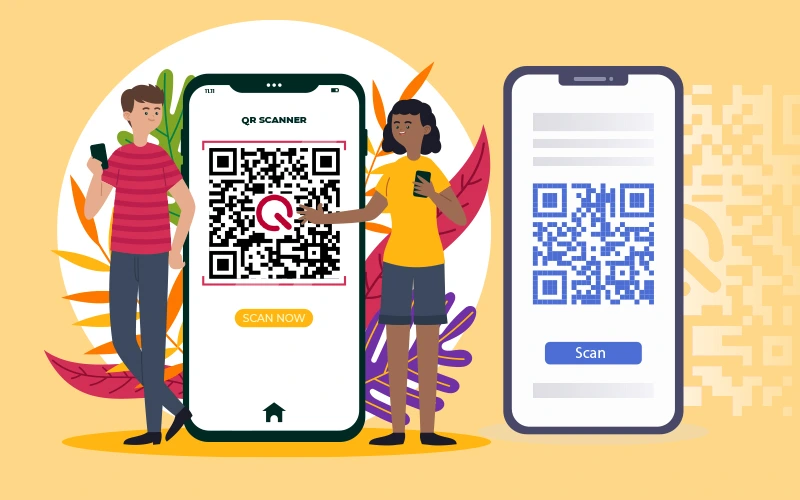
Using QR Codes: A Complete Guide
Looking to elevate your business operations or marketing strategies using QR codes but unsure where to begin? Surprisingly, these small, patterned squares were originally invented in 1994 to track car parts. Today, they’ve evolved into a versatile tool used across industries.
This guide will walk you through the benefits, best practices, and potential pitfalls of QR codes, equipping you to harness their full potential. Let’s dive in and unlock the power of this innovative technology!
Key Takeaways
- What Are QR Codes? QR codes are two-dimensional barcodes easily scanned by smartphones or QR readers.
- Why Use Them? They facilitate website link sharing, enable convenient payments, and enhance marketing campaigns.
- Applications: Businesses can leverage QR codes to promote social media, share menus, offer discounts, gather feedback, streamline operations, and even manage assets.
What Are QR Codes and How Do They Work?
A Brief History
QR codes (Quick Response codes) were developed in 1994 by the Japanese company Denso Wave to streamline tracking in automobile manufacturing. Today, they’ve grown into a global tool for sharing information, from URLs to multimedia.
How They Work
Scanning a QR code is simple:
- Open your smartphone’s camera app or a dedicated QR code reader.
- Align the camera with the QR code until it’s fully within the frame.
- Click the link or notification that appears to access the embedded content.
If your default camera app doesn’t support scanning, download a reliable QR reader from your app store.
Benefits of QR Codes
1. Effortless Sharing of Information
QR codes make sharing contact details, website links, and social media profiles seamless. Scanning eliminates the need to manually type URLs or search for online resources, creating a frictionless experience.
2. Streamlined Payments and Ticketing
Whether paying for a product or purchasing event tickets, QR codes simplify transactions. Customers can scan a code to complete payments securely or access digital tickets directly from their phones.
3. Enhanced Marketing and Advertising
QR codes bridge the gap between physical and digital marketing. They can direct users to websites, promotional content, or even interactive experiences, enabling businesses to track engagement and refine strategies in real-time.
How to Use QR Codes in Marketing
1. Promote Social Media Accounts
QR codes can link directly to your social profiles, making it easy for users to follow your brand. Adding these codes to business cards, flyers, or digital ads encourages engagement and boosts followers.
2. Offer Exclusive Discounts
Incentivize customers by placing QR codes on packaging, posters, or receipts that unlock special promotions or discounts. This strategy fosters loyalty and repeat purchases.
3. Share Menus or Product Details
Restaurants and retailers can use QR codes to provide instant access to menus, product descriptions, or nutritional information. This eliminates the need for physical materials, creating a more interactive experience.
4. Gather Feedback and Reviews
Generate insights by using QR codes to link to surveys or feedback forms. This real-time approach makes it easy for customers to share their thoughts, helping businesses improve their offerings.
How to Use QR Codes in Business Operations
1. Track Inventory and Manage Assets
QR codes simplify inventory management by enabling real-time tracking. Businesses can use QR software to scan and update stock levels, ensuring accuracy and efficiency.
2. Streamline Feedback Collection
By linking QR codes to surveys or comment forms, companies can capture customer opinions directly after a purchase or service experience, allowing for immediate adjustments.
3. Improve Internal Communication
B2B organizations can use QR codes to share updates, policies, or training materials with employees. Dynamic codes ensure content remains current and accessible.
Creating and Implementing QR Codes
Step 1: Choose a Reliable QR Code Generator
Research and select a generator that supports customization, error correction, and analytics. Test the generated code on various devices to ensure compatibility.
Step 2: Optimize Placement
Position QR codes in prominent, accessible locations, ensuring they’re visible from multiple angles. Avoid placing them in dimly lit or obstructed areas.
Step 3: Test and Track Performance
Analyze scan metrics like location, time, and device usage to gauge effectiveness. Use this data to refine campaigns and improve engagement.
Step 4: Educate Customers
Provide clear instructions like “Scan Here for a Discount” to guide users. Highlight the benefits to encourage interaction.
Best Practices for QR Code Usage
1. Keep It Simple
Ensure QR codes are easy to scan by maintaining a clean design with high contrast. Avoid overloading the code with excessive data or visuals.
2. Regularly Update Content
Dynamic QR codes let you refresh linked content without reprinting. Use this feature to keep information relevant and accurate.
3. Protect Against Fraud
Monitor your QR codes to prevent misuse. Use trusted generators and verify links before deploying them publicly.
Examples of Successful QR Code Campaigns
1. Restaurants
QR codes on menus provided customers with allergen information and real-time specials, boosting engagement and sales.
2. Travel Industry
QR codes simplified ticket purchases, improving convenience and enhancing the booking experience.
3. Marketing Campaigns
Brands used QR codes to offer exclusive discounts and access to social media campaigns, driving customer interaction and loyalty.
Challenges and Considerations
1. Compatibility Issues
Some devices or outdated software may struggle to read QR codes. Test codes on multiple platforms to ensure a seamless experience.
2. Lack of Awareness
Not all customers are familiar with QR codes. Provide instructions and explain their purpose to maximize usage.
3. Security Risks
Malicious actors may create fraudulent codes to steal data or direct users to harmful sites. Use secure generators and educate customers to scan responsibly.
Conclusion
QR codes are a versatile tool that can revolutionize how businesses interact with customers, streamline operations, and enhance marketing strategies. By following best practices and addressing potential challenges, you can fully unlock their potential and drive meaningful results for your business.
Start implementing QR codes today and watch your business operations and engagement soar!